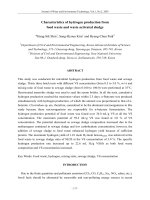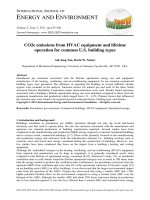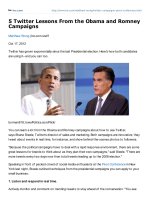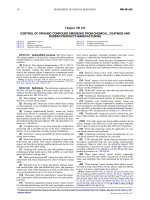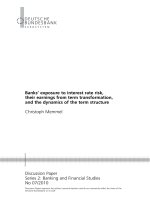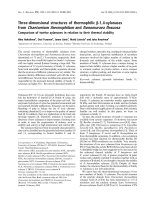wallach - protecting clients from fraud, incompetence and scams (2010)
Bạn đang xem bản rút gọn của tài liệu. Xem và tải ngay bản đầy đủ của tài liệu tại đây (1.42 MB, 243 trang )
flast01.indd xiiflast01.indd xii 12/29/2009 3:30:45 PM12/29/2009 3:30:45 PM
Protecting Clients from
Fraud, Incompetence,
and Scams
LANCE WALLACH
John Wiley & Sons, Inc.
ffirs.indd iffirs.indd i 12/29/2009 3:30:42 PM12/29/2009 3:30:42 PM
Copyright © 2010 by John Wiley & Sons, Inc. All rights reserved.
Published by John Wiley & Sons, Inc., Hoboken, New Jersey.
Published simultaneously in Canada.
No part of this publication may be reproduced, stored in a retrieval system, or
transmitted in any form or by any means, electronic, mechanical, photocopying,
recording, scanning, or otherwise, except as permitted under Section 107
or 108 of the 1976 United States Copyright Act, without either the prior
written permission of the Publisher, or authorization through payment of the
appropriate per-copy fee to the Copyright Clearance Center, Inc., 222
Rosewood Drive, Danvers, MA 01923, (978) 750-8400, fax (978) 750-4470,
or on the web at www.copyright.com. Requests to the Publisher for permission
should be addressed to the Permissions Department, John Wiley & Sons, Inc.,
111 River Street, Hoboken, NJ 07030, (201) 748-6011, fax (201) 748-6008, or
online at />Limit of Liability/Disclaimer of Warranty: While the publisher and author have
used their best efforts in preparing this book, they make no representations or
warranties with respect to the accuracy or completeness of the contents of this
book and specifi cally disclaim any implied warranties of merchantability or
fi tness for a particular purpose. No warranty may be created or extended
by sales representatives or written sales materials. The advice and strategies
contained herein may not be suitable for your situation. You should consult
with a professional where appropriate. Neither the publisher nor author shall
be liable for any loss of profi t or any other commercial damages, including but
not limited to special, incidental, consequential, or other damages.
For general information on our other products and services or for technical
support, please contact our Customer Care Department within the United States
at (800) 762-2974, outside the United States at (317) 572-3993 or fax (317)
572-4002.
Wiley also publishes its books in a variety of electronic formats. Some content
that appears in print may not be available in electronic books. For more
information about Wiley products, visit our web site at www.wiley.com.
Library of Congress Cataloging-in-Publication Data:
Wallach, Lance.
Protecting clients from fraud, incompetence, and scams / Lance Wallach.
p. cm.
Includes index.
ISBN 978-0-470-53974-3 (cloth)
1. Fraud–Prevention. I. Title.
HV6691.W35 2010
362.88–dc22
2009037068
Printed in the United States of America
10 9 8 7 6 5 4 3 2 1
ffirs.indd iiffirs.indd ii 12/29/2009 3:30:42 PM12/29/2009 3:30:42 PM
iii
Contents
Acknowledgments ix
Introduction: Every Accountant and Attorney Should
Read This Book xiii
CHAPTER 1 Meltdown 1
The Party’s Over 2
We All Know the Result 3
Grim Statistics 4
Retirement Plans and the IRS 8
Summary 12
CHAPTER 2 Everyone Needs a Family Offi ce 15
Why a Family Offi ce? 15
Retaining a Firm 18
The Family Offi ce Advantage 19
Summary 20
CHAPTER 3 Protect Your (Retirement) Assets 21
The Fiduciary Duty 21
Documenting a Process 22
Plan Options/Simple IRA 23
You Cannot Save Enough 24
Another Option—The 412(e)(3) 25
ftoc.indd iiiftoc.indd iii 12/29/2009 3:30:49 PM12/29/2009 3:30:49 PM
Contents
iv
The Cash-Balance Plan 26
Summary 28
CHAPTER 4 How Much Did You Lose Last Year? 29
Basic Financial Strategies Quiz 29
Estate and Financial Planning 30
Life Insurance 31
Succession Planning 31
The Buy-Sell 32
Medical Insurance 32
Asset Protection 32
VEBA 33
Other Post-Employment Benefi ts 33
OPEB Cost 34
VEBA Plan Benefi ts 37
Taxes 38
Retirement 39
Legislative Changes 39
HSA/HRA 39
412(e) 40
Audits 40
Shelters 41
6707A 43
Captives 50
Summary 50
CHAPTER 5 Self-Defense 51
Captive Insurance 52
Basics 52
Sharing 53
Caveats 54
Summary 55
ftoc.indd ivftoc.indd iv 12/29/2009 3:30:49 PM12/29/2009 3:30:49 PM
Contents
v
CHAPTER 6 Asset Protection Basics 57
Asset Protection—Necessity, Not Luxury 57
Who Needs Asset Protection? 58
Separating Ownership from Control 60
What Is an Asset Protection Plan? 61
What Is a Trust? 62
How Does a Trust Work? 63
How Is a Trust Used? 63
Offshore Trusts 65
Asset Protection FAQs 67
Summary 70
CHAPTER 7
Shifting the Risk Equation—Insurance
Maneuvers 73
Key Employee Insurance 73
LTCi for the Business Owner 76
Life Insurance for Business Continuation 80
Summary 81
CHAPTER 8 Reevaluating Existing Insurance 83
Evaluation or Audit 83
Consultative Leverage 87
Summary 89
CHAPTER 9 What Financial Advisors “Forget” to
Tell Their Clients 91
Fiduciary Duty 93
Summary 95
CHAPTER 10 The Truth About Variable Annuities 97
Variable Annuity Components 98
Mortality and Expense Charges 99
ftoc.indd vftoc.indd v 12/29/2009 3:30:49 PM12/29/2009 3:30:49 PM
Contents
vi
Guarantees 100
Summary 100
CHAPTER 11 What Life Insurance Agents “Forget” to
Tell Their Clients 103
Questionable Aspirations 103
Coverage Needs 104
Estate Taxes 104
The ILIT 106
Summary 107
CHAPTER 12 What You Must
Know About Life
Settlements 109
Life Settlements 109
Industry Regulation and Compliance 111
Licensing and Reporting 112
Compensation 113
Compensation Abuse 114
Suitability 115
Best Execution and Due Diligence 118
Fraud Prevention 119
STOLI 122
Evaluation and Processing 123
Tax Treatment 126
Case Studies 133
Caveat Venditor 138
Summary 139
CHAPTER 13 What Health Insurance Agents “Forget”
to Tell Their Clients 143
Out of Control Costs 143
Small Business at Risk 146
ftoc.indd viftoc.indd vi 12/29/2009 3:30:49 PM12/29/2009 3:30:49 PM
Contents
vii
The Risk of On-Site Medical Clinics 151
Using an HSA for Your Personal
Retirement 152
Creating an Employee Retirement Vehicle
153
IRS Form 8889 (HSA) 153
More Effective Strategy 154
Aggregate Cap Planning 155
HRA 156
Managing General Underwriter 158
Summary 160
CHAPTER 14 College Funding Strategies and Solutions
163
The Traditional Approach 163
Good Intentions, Disastrous
Consequences 166
Traditional Vehicles 168
Real Life 180
Summary 187
CHAPTER 15 Two Alternative Investments for Financial
Independence 189
The Tertiary Market 190
History 191
Risk 192
Reward 194
Another Alternative 194
O&G Advantages 195
Summary 197
CHAPTER 16 Avoiding Fraud: Small Business Case Study 199
Introduction 199
Suspicion 200
ftoc.indd viiftoc.indd vii 12/29/2009 3:30:49 PM12/29/2009 3:30:49 PM
Contents
viii
Investigation 201
Fraud 202
Dismissal and Prosecution 204
New Mechanisms 205
Summary 206
APPENDIX A
Best of the Best 207
Insurance Advisors 207
Investment Advisors 207
Law 209
Business Services 210
Epilogue 213
About the Author 215
About the Contributors 217
Mark Boehm, MBA, CWPP 217
Aaron Skloff, AIF, CFA, MBA 217
Carl Allen, III 218
Index 219
ftoc.indd viiiftoc.indd viii 12/29/2009 3:30:49 PM12/29/2009 3:30:49 PM
ix
I
wish to express my sincere thanks to everyone who contrib-
uted to the creation of this book. An “ instructional ” tome of
this nature, by design, relies, from the moment of inception to
the last run off the presses, on the advice and input of highly
qualifi ed experts. Although many have contributed their exper-
tise in various forms and fashions, I would be remiss if I did
not single out and acknowledge the contributions of some
people in particular.
Mark Boehm, MBA, CWPP
TM
, was instrumental in pulling
this book together. His contributions in terms of content were
outstanding, and his editorial commentary improved the fl ow
and delivery of information tremendously. His expertise was
invaluable.
Mr. Boehm received his Bachelor of Science (BS) degree
from Cornell University School of Agriculture and Life Sciences,
and Master of Business Administration (MBA) degree from
Southern Methodist University. He is a principal with Alpha
Wealth Management, a boutique fi nancial services fi rm provid-
ing asset protection, tax reduction, and advanced fi nancial
planning strategies for high - net - worth clientele. Mr. Boehm
serves as an expert consultant on all things life insurance
related — planning techniques, life settlements (retail and insti-
tutional), and captive insurance.
Thank you, Mark, for all your help and input.
Carl Allen III ’ s input regarding forensic accounting investi-
gation was key. Carl is the owner of Allen Financial Services,
Acknowledgments
flast01.indd ixflast01.indd ix 12/29/2009 3:30:45 PM12/29/2009 3:30:45 PM
Acknowledgments
x
LLC. He is a graduate of North Carolina State University (BS
Mathematics, 1972) and Durham Technical Community College
(AAS Accounting, 1976). Mr. Allen is currently a member of the
Association of Certifi
ed Fraud Examiners, the National
Association of Tax Professionals, and the National Society of
Tax Professionals. He is a volunteer representative for the NC
State University Student Aid Association, and provides support
and resources for Elon University students pursuing opportuni-
ties through their career center.
Mr. Allen has served in various fi nancial management
positions over the past 30 years with companies in the insur-
ance and construction industries. He provides accounting
and technical support for small businesses in the areas of:
fraud investigations, interim accounting management support,
accounting and project consulting, and income tax preparation
and planning.
Thanks, Carl.
Aaron Skloff, AIF, CFA, MBA, provided much of the content
for this book. Let me outline for you briefl
y a few of his accom-
plishments so you can understand the level of advice you ’ re
about to receive.
Mr. Skloff received a Bachelor of Science (BS) degree in
accounting from Pennsylvania State University ’ s Smeal College
of Business and Master of Business Administration (MBA)
degree in fi nance from New York University ’ s Stern School of
Business. He is a Chartered Financial Analyst (CFA), a member
of the CFA Institute (formerly the Association for Investment
Management and Research) and an Accredited Investment
Fiduciary (AIF).
He has taught fi nance courses through Rutgers University.
His equity research reports have been published on the two
largest fi nancial research databases, First Call and Multex.
During the course of his professional career, he has been cited
by the Associated Press, BusinessWeek, Dow Jones, Fortune,
flast01.indd xflast01.indd x 12/29/2009 3:30:45 PM12/29/2009 3:30:45 PM
Acknowledgments
xi
Princeton Business Journal, Reuters, Wall Street Journal, and
other news organizations.
Mr. Skloff is CEO of Skloff Financial Group, a register
investment advisor fi
rm based in Berkeley Heights, New Jersey.
The fi rm specializes in fi
nancial planning, investment manage-
ment, and risk management for individuals and families and
group benefi t for employers.
Thank you, Aaron.
I ’ d also like to gratefully extend my sincere appreciation to
all the people from John Wiley & Sons who were instrumental
in bringing this book to press.
Lance Wallach
flast01.indd xiflast01.indd xi 12/29/2009 3:30:45 PM12/29/2009 3:30:45 PM
flast01.indd xiiflast01.indd xii 12/29/2009 3:30:45 PM12/29/2009 3:30:45 PM
xiii
Every Accountant and Attorney Should Read This Book
Honey, I forgot to duck …
— World Heavyweight Champion Jack Dempsey after losing
the heavyweight title to Gene Tunney in 1926
F
or better or worse, it is the year of Bernie Madoff. His
investment fi rm, a hollow Trojan Horse parked on Wall
Street, was emblematic of a fi nancial system that strangled itself
on opportunistic lies about complexity and global markets.
Complexity in volatile trading markets certainly exists, but
too often the fund packaging nomenclature was used to shield
mediocre and abysmally poor fund managers from the results
of their shenanigans, operating as a buffer between the manag-
ers and their clients. Arias for what used to be called merely
“ trading ” became surgery on fi nancial instruments and rebun-
dled new packages.
The problem, as one analyst said, was that these people
claimed sophistication but they had no artistry.
In the arts and fi nance, people follow stars.
Once Bernard L. Madoff ’ s mysterious but outperforming
methodology gained public traction, the volume of investors
lined up to suck on the teat of putative success and was the
line around the block in posh zip codes. Business owner –
investors might have camped out in line, too, but they needed
to be at work in the morning to face the constant purveyors
of erosion to their businesses.
Introduction
flast02.indd xiiiflast02.indd xiii 12/29/2009 3:30:48 PM12/29/2009 3:30:48 PM
Introduction
xiv
Madoff Investment Securities garnered much privately held
largesse. And yet, believe it or not, there may be worse players
out there than “ the Bernster. ” Corporate workers know
their 401(k)s or pension incentive plans are faring to the bad
side lately.
If workers want to feel better, they should look west — to
California to be exact. The Sunshine State holds publicly funded
asset pension trusts as large as a roundup of third - world debtor
nations. Guess how much they ’ ve lost recently? If you ’ re a
public employee, you need to know, and you need to know
why. If you ’ re a business owner, you also need to know how
and why.
The key margin is the players between corporate and public
entities. That would be you — small - and mid - size business
owner – investors. As if you ’ re not burdened enough, no longer
can you afford to let a rising stock market raise all boats —
drownings, sharks, and icebergs have already been sighted.
You cannot afford to calculate mystery black box schemes
perpetrated by former NASDQ Chairs — one Bernard Madoff to
be exact. Due diligence in all phases of business operations
seems in order. This diligence will require no sleep for the
next, oh, 10 to 20 years.
Not really, if you can answer one basic question:
Why don ’ t “ experts ” read the IRS code like a medical school
manual of surgery?
Answer(s):
First, there aren ’ t that many “ experts, ” and those that are
seek to keep a low profi
le (in comparison to TV talking heads
who make their money from boob tube salaries, not real - world
contingencies), because they have had a loyal clientele for
decades. The sad news is — they don ’ t need you; in fact, they
probably couldn ’ t fi
t you into their mad schedule.
Second, capitalism does share in archetypes that fl y below
the radar (because they ’ re legal strategies) and rewards due
flast02.indd xivflast02.indd xiv 12/29/2009 3:30:48 PM12/29/2009 3:30:48 PM
Introduction
xv
diligence with annual gains rather than one - time overlarge
payouts (the latter used to be called gambling).
Third, a team approach to business investing, utilizing a tax
strategist, insurance — legal specialist and fi
nancial planner, who
actually talk to and meet one another — will, in the long run,
outperform the one - shot wonders.
In this book, we provide you the blueprint. You need to
take the necessary actions. Business owner – investors are the
middle layer between public service – government organizations
and multinational corporations. You are the serious music the
U.S. dream and economy thrive upon.
I would say you need to learn how to box.
flast02.indd xvflast02.indd xv 12/29/2009 3:30:48 PM12/29/2009 3:30:48 PM
flast02.indd xviflast02.indd xvi 12/29/2009 3:30:48 PM12/29/2009 3:30:48 PM
1
Meltdown
CHAPTER
1
Muhammad Ali: Superman don ’ t need no seat belt.
Flight Attendant: Superman don ’ t need no plane, neither.
T
he U.S. fi nancial system meltdown has grimly scythed
decades of accumulated business profi t, investment, and
personal wealth. As we have seen, investors undervalued their
own rationality and overvalued chaotic wealth management
schemes masquerading as complex asset management in a
global economy. Investors dumped business earnings, pension
assets, and personal funds into investment portfolios without
due diligence as to the logic and structural soundness of those
investments and their strategic economic orientation.
Counterintuitively, many wealthy investors and business
owners took leaps of faith with hard - won assets into complex
investment schemes they didn ’ t understand because returns
were bountiful. The hard work processes by which investors
grew their businesses or their wealth did not seem to apply to
strategically marketed programs devised by Wall Street wizards.
“ The wizards must be smarter and more inventive ” was the
mantra. It was an era where not paying attention yielded robust
earnings.
c01.indd 1c01.indd 1 12/29/2009 3:25:17 PM12/29/2009 3:25:17 PM
Protecting Clients from Fraud, Incompetence, and Scams
2
The Party ’ s Over
The charlatans have now been revealed and returning to earth
awash in lost assets has been a hard lesson learned for many
business and personal investors. Fear of any kind of strategy
beyond the most basic principles of accounting math has turned
fi nancial markets into rigid, ossifi ed institutions. Credit is tight;
doubt is rampant. But fear need not overtake common sense.
If one is strategically poised to act, there are methods to reap
opportunities even within the constant inhalation of a bad news
economy.
There are ways to maximize wealth assets through sound
tax strategies aimed at reducing exposure to IRS audits, while
freeing liquidity for further investment income growth. Part of
the picture is understanding what the U.S. government has and
has not done in the fi nancial sector.
The U.S. government failed to regulate its own legislative
loosening of the credit and investment markets. The govern-
ment allowed fi nancial businesses that previously dealt in single
issue items, such as credit allocation (banks), insurance (insur-
ance companies), and tax protection (accounting fi rms) to
become full - service investment/banking/insurance hundred -
headed hydras. With the ability to manipulate different asset
classes, many of these businesses grew astronomically by
forging new markets out of fringe niches and clients they previ-
ously would not have pursued.
Much of the growth was built on Ponzi - type schemes of
trading one asset class for another, rebundling (while claiming
it was an asset protection maneuver), and charging transaction
and management fees for transferring and translating assets into
different holding tanks. Ethical portfolio diversity became a joke.
Forensic auditors will spend years trying to unravel the
origination of lost portfolios and their mutation into worthless
products that propped up marketing schemes.
c01.indd 2c01.indd 2 12/29/2009 3:25:17 PM12/29/2009 3:25:17 PM
Meltdown
3
We All Know the Result
Because the government was involved in allowing multipur-
pose fi nancial institutions to pursue growth by any means
necessary, the government now stands confused, dazed, and
unable to act under the fallout from the variety and volume of
reckless fi nancial transactions it helped perpetuate. In fact, it is
throwing more money into the hollow house called Wall Street,
assuming that the perpetrators will suddenly ethically encumber
themselves and fi x the problem.
Meanwhile, the Security and Exchange Commission (SEC),
the so - called regulatory agency of the U.S. fi nancial system, is
like a lost orphan, its budget miniscule in comparison to the
largesse tossed to the big dog bankers and their pals. Shouldn ’ t
the budget allocation be the opposite until we have reviewed
and identifi ed the malfeasance that brought down the system?
There is another looming storm on the horizon that could
swamp any economic lifeboats sent out into the water by the
government. There is the potential for a catastrophic failure of
retirement funds in the United States, affecting nearly one - third
of the pension plans existent. With baby boomers set to retire
in massive numbers, such a failure would further erode a weak,
destabilized economy.
In 2006 Congress passed the Pension Protection Act, man-
dating that companies with defi ned benefi t pension programs
be fully funded, as measured by the ability to pay out money
to all retirees should the latter decide to withdraw their accrued
assets. Of the 500 largest U.S. companies, more than 200 do
not meet the Pension Protection Act standard in 2009.
Standard & Poor ’ s 1500 Index of corporations reveals how
dire the situation has become: The Index corporations moved
from a $60 billion pension plan surplus at the end of 2007 to
$409 billion defi cit before the end of 2008. Defi ned benefi t
pensions (usually, where an employee payroll deduction is
c01.indd 3c01.indd 3 12/29/2009 3:25:17 PM12/29/2009 3:25:17 PM
Protecting Clients from Fraud, Incompetence, and Scams
4
matched by the company into the employee ’ s retirement fund)
at these companies are part of a potential nightmare scenario
even in good economic times, and we are entering an unde-
fi ned period of economic uncertainty and groping in the dark.
When revenues decline in an economic crunch, payroll
must be met at salaries that haven ’ t declined. In the worst situ-
ation, a company may have to decide between meeting payroll
and matching payroll - defi ned pension requirements. Corporate
pension funds are troubled and clearly face the problem of
underfunding. Many of the corporate pension funds invest their
money conservatively. There are, however, a group of pension
fund managers who have not invested conservatively or wisely
and they are the fi rst wave of a larger pension fund tsunami
that could catapult the U.S. economy into a stunning freefall.
The snowball rolls downhill: jobs are cut, stocks consis-
tently trend downward, reducing a company ’ s investment
stream, destabilizing the stock market and the company ’ s ability
to remain productive or even solvent.
Public pension funds and federal retirement accounts hold
approximately $3.5 trillion in their accounts. There is another
$1 trillion in unionized corporate workers who are part of the
management team deciding fund investments. Together, these
funded retirement vehicles cover approximately 27 million
Americans and account for more than 30 percent of the U.S.
retirement pension fund system. A failure of 30 percent of the
system would be catastrophic to United States and international
markets and to the personal retirement benefi ts of the invested
potential pensioners.
Grim Statistics
The bad news is that 30 percent was at risk before the current
fi nancial meltdown. The worse news is some pensions are close
to defaulting without cash infusions that would have to come
c01.indd 4c01.indd 4 12/29/2009 3:25:17 PM12/29/2009 3:25:17 PM
Meltdown
5
from taxpayers, necessitating higher taxes, less spending, and
an unprecedented economic crisis stretching into the foresee-
able future. Consider these numbers:
By 2008, just before the stock market began to tank, an
estimated 40 percent of union - led pension funds were under-
capitalized, meaning there was no guarantee the funds had
enough money on hand to pay out member benefi ts.
California has two of the largest pension funds in the
country: CalPERS, which is the biggest U.S. pension fund,
covers California public employees, and CalSTRS, the state
teacher pension fund. Their combined assets, at their zenith in
2007, weighed in at more than $400 billion, more than the GDP
of some nations. By February 2009, the funds had lost 26
percent of their value from July 2008. CalPERS was more than
100 percent funded in summer 2007; it is currently at 70 percent
(funding) and declining.
Adding to an already grim picture is CalPERS unaccounted
investment in the California real estate market, which has
descended faster than most markets nationwide. Things are
not looking much better for 2009. In February, LandSource
Communities Development, which owns 15,000 acres north of
Los Angeles, announced it was fi
ling for bankruptcy protection.
The property developer ’ s backer? None other than CalPERS.
The California city of Vallejo fi led for bankruptcy in May
2008, in great measure because of an insolvent public pension
fund. San Diego ’ s pension fund defi
cit may cause it to follow
Vallejo into the abyss.
Connecticut ’ s state pension fund is estimated to be only 50
percent funded in comparison to its membership base.
Underfunded VEBAs (Voluntary Employee Benefi ciary
Associations) have been used by corporations to negotiate their
way out of seemingly intractable health cost - pension plan obli-
gations. The Big Three automakers recently negotiated VEBA
agreements with their union employees, transferring $56.5
c01.indd 5c01.indd 5 12/29/2009 3:25:17 PM12/29/2009 3:25:17 PM
Protecting Clients from Fraud, Incompetence, and Scams
6
billion to a United Auto Workers (UAW) – managed retiree health
care VEBA, allowing the parent corporation to erase $88.7
billion in long - term pension obligations.
The math says there is an immediate $30 billion - plus funding
shortage. Union VEBA management will be crucial; there is no
corporate safety net should the plan fail. UAW president Ron
Gettelfi
nger said the General Motors VEBA would be safe for
80 years, but the recent track record for underfunded VEBAs
is not good.
For instance:
Caterpillar transferred $32.3 million to a UAW retiree health
plan in 1998. The fund was bankrupt by 2004. Renegotiation
and lawsuits ensued. Also in 2004, a UAW - Detroit Diesel health
care fund was depleted, resulting in more legal action.
The GM VEBA will probably fail. If UAW projections are
wrong, for example, about the rate of increase in health care
costs, they will be woefully wrong about how long this fund
will remain solvent. The cost of health care escalates each year
and the money used to seed the VEBA was not enough to
begin with. Health care increases were estimated by the UAW
at 5 percent, with invested VEBA funds increasing by 9 per-
cent. The scenario could turn out to be exactly the opposite,
or worse.
Prior to 2008 ’ s meltdown, comparative studies between
public and private employee investment programs indicated a
burgeoning problem in the former. A study of 200 state and
local pension funds from 1968 to 1986, performed and analyzed
by Olivia Mitchell, executive director of the Pension Research
Council at the Wharton School, discovered that public pension
investments substantially underperformed against other pooled
funds, and quite frequently below market indexes.
The evisceration of public pension funds began before
recent economic quagmires. Prior to the 1970s the funds were
managed conservatively, utilizing fi duciary methods aimed at
c01.indd 6c01.indd 6 12/29/2009 3:25:17 PM12/29/2009 3:25:17 PM
Meltdown
7
protecting the future pensioners and tax payers, who end up
footing the bill if a fund defaults.
Three things changed in the 1970s and into the 1980s:
1. Politicians began to get involved in the direction of fund
management.
2. Pension fund managers began to “ play ” emerging markets
and potential sources of elevated revenue: corporate bonds,
stocks, foreign instruments, real estate, private equity com-
panies, and hedge funds.
3. Union and public employee pension funds initiated, some-
times against membership understanding or wishes, a trans-
fer of assets into socially responsible investments. Investment
research company Morningstar said that as of November
2008, 76 of 91 socially responsible stock funds were per-
forming at sub - Dow levels. Last December, the Sierra Club ’ s
social fund liquidated its assets due to consistent losses.
All three of these developments have accumulated nega-
tively; the union and public pension fund system is in total
woefully underfunded. The default costs, combined with reces-
sion, defl
ation, and the stimulus plans guaranteed to raise taxes,
would be diffi cult to recoup except by further tax increases,
promoting the vicious depressive economic environment in
which we are currently embroiled.
If public pension funds cannot meet their obligations to
cover promised member benefi ts, the only available resource
to siphon money from will be taxpayers — the same taxpayers
who are watching their personal retirement portfolios fall off a
cliff. As a business owner, you need to protect yourself and
your assets with a smart tax and investment strategy.
It is crucial that the small business owner understand tax
and investment strategies that not predicated on traditional
pension planning methods. Business survival may be at stake.
c01.indd 7c01.indd 7 12/29/2009 3:25:17 PM12/29/2009 3:25:17 PM
